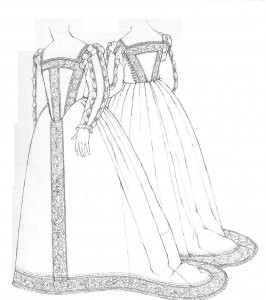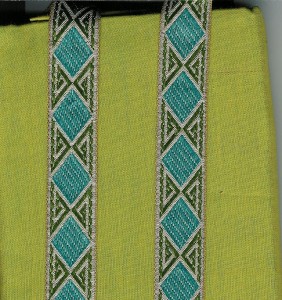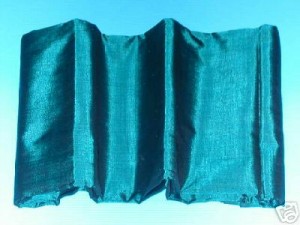WARNING: The following contains a RANT. I hereby tender my apologies to all the might be otherwise offended.
Furthermore, this has been copied over from my other blog from 2008, and while updated because the show’s costuming department cleaned us their act and as each season got better, I still have issues, but it still bears repeating in a more appropriate arena.
I just finished watching “The Tudors” on Video on Demand. In addition to really wishing that the love of my life knew more about 16th century history, I spent even more time constraining myself from yelling back at the telly about the very pretty to look at, but oh so horribly wrong costuming […like the TV could do anything about it.] Dudes, you do not spend half of your adult life getting paid by people to research and make and oh yes, beta testing patterns for Reconstructing History and not end up without learning a thing or two about Tudor and Elizabethan clothing.
I ask the somewhat rhetorical question:
How it is possible that with the plethora of readily available resources of books, innumerable portraits and bona fide professional Tudor and Elizabethan costumers who have meticulously produced patterns from extant garments which they sell on the freakin’ Internet no less (Ninya Mikhaila and Jane Malcolm-Davies, authors of The Tudor Tailor and renowned English Tudor era costumers and Kass McGann of Reconstructing History in the United States), that so many things could be so horribly wrong? The answer lies within the costumer’s very own words: it was deliberate.
To the costumer on this show, I commend you for your efforts of having to coordinate such a volume of work, but it stops there.
I watched your interview on Showtime’s website. I fully understand your desire and felt need to make the clothing accessible to the modern viewer. I really do. I did Renaissance Faire costumes for performers for nearly 25 years and yes, certain concessions were made to help convey a sense of class structure to help the average Faire goer distinguish between peasant, middle class and nobility. And yes, other concessions were and are still being made because of the climatic differences between 16th century England and 21st century United States, specifically southern California.
However, because so many of us have grown up on our local Faires, and have seen the multiple Oscar winning “Shakespeare in Love” innumerable times, and have seen both “Elizabeth” movies (both not without their faults, but still brilliantly done), and will be seeing “The Other Bolyen Girl” shortly as well as numerous other 16th period pieces: this era of clothing is not new to us. Early Tudor attire might seem a bit odd with its strange sleeves and ladies’ hats that look more like bird houses than hats, but still….
Yes, I agree that the King and his nobles were the equivalent of rock stars in their day and that their clothing would and should reflect that. No argument there. What I take issue with is:
- Mixing eras: The theory is that this drama is set in the 1520’s and perhaps even as late as1530. However, I saw clothing that was decidedly Elizabethan in design rather than Tudor. A 1580’s doublet is not quite the same as the gown men were wearing in the 1520’s. The character of Sir Thomas Bolyen was dressed far more appropriate for the period. Contemporary portraits of Henry VIII prove that. These two examples 1520, two years prior to Anne’s arrival at Court and http://tudorhistory.org/henry8/younghenry.jpg and 1526, when it is purported that Henry first took notice of her http://tudorhistory.org/henry8/henrymin.jpg. Another example is a somewhat famous portrait for 1536, the year Anne was beheaded. http://tudorhistory.org/henry8/holbeincopy.jpg.
(As a side note, it should be noted that Henry was 45 years old at the time. Anne was a mere 27 …34, depending on your sources. So the actor playing Henry is a bit too young and besides, the actor cast as Buckingham would have been a much better cast both in physical appearance and “presence” — I’m agreeing with my Pastor on this one — gotta sex it up for the ignorant masses …grumble, grumble.)
- Hair: Men’s hair was too short and the women’s hair was down. Find me a source or non-allegorical portrait to prove otherwise. The wearing on women’s hair down is a 20th century development. Something about it being a sin for a women to show her hair in public.
- Hats: Where were they? Not nearly enough hats. Everybody wore some type of head covering at almost all the time. Anybody aware of the fact that Henry passed a law that everyone in the realm must a wool hat on Sunday or be fined or imprisoned? Something about it being a sin to have your head uncovered for anyone but the Lord?And what’s up with the flocked fishnet veiling Anne was wearing?And for that matter … where were the French Hoods that she brought to England from the French Court that it’s said that she wore nothing else. Please do not tell me that those tiaras-thingies that the actress wore are French hoods.
- Sleeves: Again, where were they? No one would have been seen sleeveless. Again, exposed bare flesh was right out. Not a single one of those funky false hanging fold-back sleeve to be seen.
- Chemises: Again, where were they? (Yes, yes, I’m sounding like a broken record.) We’re talking about a time period that didn’t bathe regularly and when they did, they did it in their all-purpose undergarment know as a chemise. Again, exposed bare flesh, yadda, yadda, yadda.
- Necklines: Way too much cleavage being flashed about. Clear examination of portraits prove that. The best way to simply describe Tudor era necklines is to locate your armpit, and then connect the dots as it were between the armpits across the chest and you’ve got a proper neckline.
- A visible zipper placket: self-explanatory.
- Recycled costumes: I’m down with the idea of saving time and money and taking advantage of Western Costumes when you can. But if you’re going to rent costumes, could you make sure that they weren’t worn by Gwyneth Patrow in Shakespeare in Love? (The orange velvet picadilled jacket and tapestry skirt when she met with Wesicks and slapped him for kissing her and the pale green surcoate / dressing gown that she wore throughout the movie.)
Here’s the thing, the key to good period costuming is to recognize that whatever we do that it is an interpretation of historic design – a sentiment that I used as my business’ tagline for many, many years. We can never fully reproduce clothing in the manner that they did then and make it cost effective for any sort of production. Personal costumes where we have the luxury of hand-sewing is another story. The fact of the matter is there are weaving and construction techniques and fabrics that have been lost to us five centuries later. What we can do is be a faithful as possible to dutifully convey the details of the period as accurately as possible. There are times where we must substitute fabrics because the period fabric has been lost in time or is completely cost prohibited. Been there, done that … However, as I progressed in my craft I learned what and when to substitute and how to do it convincingly.
Perhaps more importantly, we should never “dumb-down” our work and make concessions to audience to the point where we suddenly become Doc Brown dressing Marty McFly in 1950’s western wear (from Nudie’s Rodeo Tailor, no less) to go back to 1885 and expecting him to seamlessly blend in. It never works and I believe we lose a certain amount of integrity in doing so.
And to answer to unasked question: YES, yours truly is available for hire as a consultant or outside contractor. Travel on Sundays is always out of the question.
 Like everyone else, I fell in love with this gown the first time I opened my copy of Patterns of Fashion. So the winds of fortune finally blew my way clear to make this delightful gown . . . in 70’s colors so hideous, it screams 16th Century Italian across three counties. Back in the day, next door to this HOF (that I was babysitting) was a JJ Newberry’s, and they were having a clearance sale (they were closing out their fabric department) and lo and behold, I picked up this trim for 50 cents a yard. I couldn’t resist. I was going through my rebellious RPF costuming phase and wanted to see how far I could push the envelope before they threw me out for clashing or fainted . . . or offered me the head costomer’s job because I knew more than she did.
Like everyone else, I fell in love with this gown the first time I opened my copy of Patterns of Fashion. So the winds of fortune finally blew my way clear to make this delightful gown . . . in 70’s colors so hideous, it screams 16th Century Italian across three counties. Back in the day, next door to this HOF (that I was babysitting) was a JJ Newberry’s, and they were having a clearance sale (they were closing out their fabric department) and lo and behold, I picked up this trim for 50 cents a yard. I couldn’t resist. I was going through my rebellious RPF costuming phase and wanted to see how far I could push the envelope before they threw me out for clashing or fainted . . . or offered me the head costomer’s job because I knew more than she did. 
